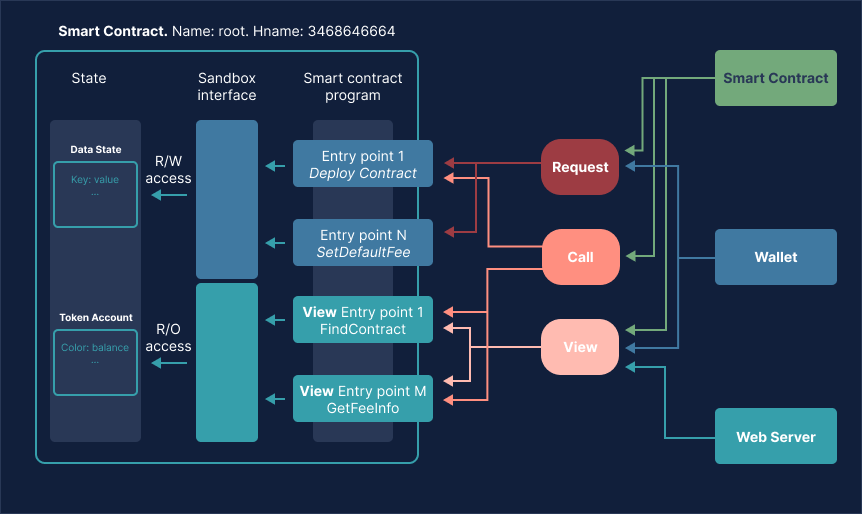Anatomy of a Smart Contract
Smart contracts are programs that are immutably stored in the chain.
Through VM abstraction, the ISC virtual machine is agnostic about the interpreter used to execute each smart contract. It can support different VM types (i.e., interpreters) simultaneously on the same chain. For example, it is possible to have Wasm and EVM/Solidity smart contracts coexisting on the same chain.

Identifying a Smart Contract
The ISC core contracts and WASM contracts on the chain are identified by a hname (pronounced
"aitch-name"), which is a uint32 value calculated as a hash of the smart contract's instance name (a string).
For example, the hname of the root core contract
is 0xcebf5908. This value uniquely identifies this contract in every chain. This does not apply to EVM contracts.
State
The smart contract state is the data owned by the smart contract and stored on the chain. The state is a collection of key/value pairs. Each key and value are byte arrays of arbitrary size (there are practical limits set by the underlying database, of course). You can think of the smart contract state as a partition of the chain's data state, which can only be written by the smart contract program itself.
The smart contract also owns an account on the chain, stored as part of the chain state. The smart contract account represents the balances of base tokens, native tokens, and NFTs controlled by the smart contract.
The smart contract program can access its state and account through an interface layer called the SandboxA controlled environment where programs can be tested safely.. Only the smart contract program can change its data state and spend from its account. Tokens can be sent to the smart contract account by any other agent on the ledger, be it a wallet with an address or another smart contract.
See Accounts for more information on sending and receiving tokens.
Entry Points
Each smart contract has a program with a collection of entry points. An entry point is a function through which you can invoke the program.
There are two types of entry points:
- Full entry points (or simply entry points): These functions can modify (mutate) the smart contract's state.
- View entry points (or views): These are read-only functions. They are only used to retrieve the information from the smart contract state. They cannot modify the state, i.e., they are read-only calls.
Execution Results
After a request to a Smart Contract is executed (a call to a full entry point), a receipt will be added to
the blocklog core contract. The receipt details the
execution results
of said request: whether it was successful, the block it was included in, and other information.
Any events dispatched by the smart contract in context of this execution will also be added to the receipt.
Error Handling
Smart contract calls can fail: for example, if they are interrupted for any reason (e.g., an exception) or if it produces an error (missing parameter or other inconsistency). Any gas spent will be charged to the sender, and the error message or value is stored in the receipt.